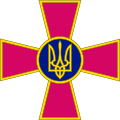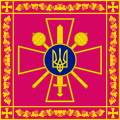Ministry of Defence (Ukraine)
| Міністерство Oборони України | |
Minister of Defence | |
| Child agencies | |
|---|---|
| Website | mil.gov.ua |
The Ministry of Defence of Ukraine (
The ministry was established in Ukraine on 24 September 1991,[1][2] one month after Ukraine's declaration of independence resolution. The ministry was put in charge of all Soviet military forces reorganization on the territory of Ukrainian jurisdiction.[1][5] In 1994, Ukraine voluntarily gave up all nuclear weapons. The ministry spent significant funds eliminating nuclear weapons, military bases and equipment to meet Treaty on Conventional Armed Forces in Europe requirements.
In 2022 it was planned to provide 5% of Ukraine's GDP for the needs of the Ministry of Defence. In July 2022, amidst Russian invasion of Ukraine, the Ministry of Defence of Ukraine stated that it spends a years' budget of the ministry every month of the war with Russia.[6]
Mission
As ratified by the Verkhovna Rada (Ukrainian parliament), the major objectives of the ministry are preventing hostility, structuring the military, and repelling all types of aggression (both in country and internationally). Ukrainian security policies are based on non-intervention, respect for the national borders and sovereignty of other states, rejecting any use of force as an instrument of influence.[7]
Because of political sensitivity, the military doctrine, similar to Ukraine's security policy, does not point out a specific threats. It rather refers to a "states, whose consistent policy presents a military threat, or leads to interference in the internal affairs of Ukraine, or encroaches Ukraine's territorial integrity and national interests."[7]
Hence, the Ministry of Defence is responsible for:
- Support to Armed Forces day-to-day activities
- Mission and mobilization readiness
- Combatant value
- Training to fulfil assigned missions and engagement
- Manning and appropriate training
- Weapons and military equipment supplies
- Material, funding and other resources in accordance with requirements
- Control over the effective use of these resources
- Developing interoperability with executive power, civilian agencies and civilians
- International military and military-technical cooperation
- Control over compliance of Armed Forces activities with the Law
- Developing conditions for civilian control over Armed Forces.[8]
History
Early 20th century
The first military executive office was created on 28 June 1917, as part of the
At the same time, Bolsheviks established their own executive branch as part of the
On 24 January 1919, the People's Commissariat of Military Affairs of the Ukrainian SSR was established. It was dissolved in the summer of 1919 due to the military union that was signed between the governments of the
In 1944, there also existed the People's Commissariat of Defence of the Ukrainian SSR.[10]
Post-Soviet Union


In 1991, Ukraine inherited one of the largest military forces, not only in the post-communist area, but in all of Europe (excluding Russia).
On 24 September 1991,
The political preference of Ukraine authority on the non-nuclear and non-coalition state status was made to be the foundation of the Armed Forces organization process. But equally important to the foundation were the limitations connected with approval of the Agreement "On conventional Armed Forces in Europe" and implementation of the
In a short span of time, Verkhovna Rada of Ukraine passed some legislative acts concerning the military sphere: The conception for Defence and organization of the Armed Forces of Ukraine, the resolution "On
In addition, Ukraine began its nuclear weapons disarmament program in the early 1990s. By 1 June 1996, there were no nuclear weapon in Ukraine.[13][14]
During the first few years of independence, the Defence Ministry built the basics for a functional defence system in spite of the difficulties of that time, which included
A shuffle in the military department's administration had a rather negative effect on the process of military development. From 1991 to 1996, three
This problem was complicated by Ukraine's instability, connected with international dislocation of military personnel. About 12,000 officers pledged their allegiance to other countries (mostly Russia) and more than 33,000 personnel came back to serve the Ukrainian army between 1991 and 1994.
No doubt, that the main reason of dissatisfied realization of the main procedures of the Armed Forces development process was permanent reduction of common part of expenses for National Defence at all; expenses for the Armed Forces, purchases of
In 2016, Ukrainian defence minister Stepan Poltorak initiated a reform of the Ministry of Defence processes assisted by a group of advisers from the U.S., Canada, Poland, Lithuania and the United Kingdom, named "The Quint". In addition, several Western countries launched a training program to support the Armed Forces of Ukraine, such as the British Operation Orbital and the Canadian Operation Unifier.[15]
On 15 February 2022, the Ukrainian Ministry of Defence said in a tweet that its website was temporarily brought down, likely as a result of a
On 30 April 2023, the Defence Ministry of Ukraine posted a tweet that depicted a unique yet offensive blend of American actress
Military development
| Armed Forces of Ukraine |
|---|
 |
| Main branches |
|
| Law enforcement |
| Related services |
| Intelligence |
| History of the Ukrainian Military |
|
The progress of Ukraine's military organization and development are (by the Ministry of Defence) divided into three main periods:
- The first period began from 1991 to 1996 – the initial establishment of the Armed Forces of Ukraine, reorganization;
- The second period from 1997 to 2000 – further organization and development of the Armed Forces of Ukraine;
- The third period 2001 on – reforming and development of the Armed Forces of Ukraine, introducing new military equipment.
First stages
The aspects of the first period of development were the forming the legal foundation of the Armed Forces activity, reorganization of its structure, establishment of the corresponding executive structures and supporting structures, and other elements, which were necessary for its functioning.
The first stages of development of the Armed Forces also began the reduction of the military institutions, number of personnel, and number of armament and
At the end of 1996, more than 3500 different military institutions and 410000 personnel were discharged. Also, the number of armament and defence technologies was decreased: combat aircraft – by 600 units, helicopters – by 250, the garrison tanks and combat armed vehicles by 2400 and 2000.[8]
Throughout the 1992–1997 the army was reduced by 400,000 servicemen. More than 1300 units, organizations, command and control installations were disbanded during that period. By the end of 1999 the organizational strength of the Armed Forces is to number around 400,000 men, including 310,000 military and 90,000 civilians.[12]
Future development
According to the Defence Ministry, it plans to create a system of civilian control over the armed forces, illuminate the tasks of the highest leadership and respective state and military organizations in terms of Armed Forces command and control. Therefore, the
Command and control over the Armed Forces and other military formations in emergencies is executed by the President of Ukraine through the general headquarters (similar to the Soviet
Realization of the basics of the Armed Forces
Ukraine has announced the goal of making its army all-professional by 2015. In the first stage in the years 2001 through 2005, around a third of the army servicemen were replaced with professionals. During the third stage (in the years 2006 through 2010), the quantity of professionals serving in the army is planned to increase up to 50%. And, lastly, at the final stage (scheduled to complete by 2015), the army will become all-professional. Army downsizing will accompany the transition to an all-professional army.[20]
Structure
The Ukrainian Defence Ministry is responsible for the management of territorial defence, military development, mobilization in the case of war and combat readiness. The General Staff of Ukraine has the task of planning defensive and operational management of the armed forces. The General Staff is subordinate to the Defence Minister of Ukraine.
Since 1 January 2019 the Minister of Defence must be a civilian.[21]
References
- ^ a b c "Міністерство | Міноборони".
- ^ a b c Government portal :: Ministry of Defence of Ukraine
- ^ "Питання Міністерства оборони України". Офіційний вебпортал парламенту України.
- ^ "Official website of the Ministry. Contact Us". 2017.
- ^ "Book_WP_2006_ENG_nver.indd" (PDF). Archived from the original (PDF) on 8 November 2007.
- ^ "Олексій Резніков: "Закінчити війну до кінця року абсолютно можливо"". BBC News Україна (in Ukrainian). Retrieved 25 July 2022.
- ^ a b c "Archived copy" (PDF). Archived from the original (PDF) on 26 September 2006. Retrieved 17 November 2007.
{{cite web}}: CS1 maint: archived copy as title (link) - ^ a b "Archived copy" (PDF). Archived from the original (PDF) on 10 September 2008. Retrieved 10 September 2008.
{{cite web}}: CS1 maint: archived copy as title (link) - ^ People's Commissariat of Military Affairs of the Ukrainian SSR at Ukrainian Soviet Encyclopedia
- ^ People's Commissariat of Defence of the Ukrainian SSR at Ukrainian Soviet Encyclopedia
- ^ James Sherr, 'Ukraine's Defence Reform: An Update', Conflict Studies Research Centre, 2002
- ^ a b "Ministry of Defense - Ukraine". www.globalsecurity.org.
- ^ "Міністерство | Міноборони".
- ^ "Ukraine: History of the Proposal for a NWFZ in Europe". Archived from the original on 7 September 2008.
- ^ Nicholls, Dominic (10 April 2022). "How Britain helped bring Ukraine's army up to scratch". The Daily Telegraph. Retrieved 10 April 2022.
- ^ Miller, Maggie (15 February 2022). "Ukrainian Ministry of Defense websites hit by cyberattack". Politico.com. Archived from the original on 15 February 2022. Retrieved 15 February 2022.
- ^ "Cyberattack hits Ukrainian government sites, major banks". Defense News. Associated Press. 15 February 2022. Retrieved 20 February 2022.
- ^ "ukraine kali: Ukraine's defence ministry deletes tweet allegedly depicting Goddess Kali following online outrage". The Economic Times. Retrieved 2 May 2023.
- ^ Livemint (2 May 2023). "'Regret depicting goddess Kali in distorted manner,' Ukraine govt". www.livemint.com. Retrieved 2 May 2023.
- ^ http://merln.ndu.edu/whitepapers/Ukraine_Eng-2005.pdf Archived 2007-11-27 at the Wayback Machine, page 4 of 136
- (13 October 2018)
